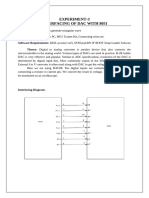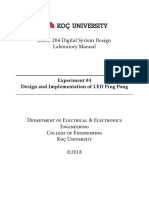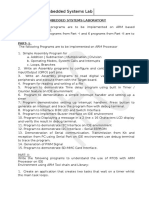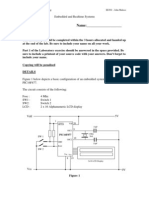21BLC1151LAB4
21BLC1151LAB4
Uploaded by
Aditya Kumar Jha 21BLC1151Copyright:
Available Formats
21BLC1151LAB4
21BLC1151LAB4
Uploaded by
Aditya Kumar Jha 21BLC1151Original Title
Copyright
Available Formats
Share this document
Did you find this document useful?
Is this content inappropriate?
Copyright:
Available Formats
21BLC1151LAB4
21BLC1151LAB4
Uploaded by
Aditya Kumar Jha 21BLC1151Copyright:
Available Formats
School of Electronics Engineering (SENSE)
B. Tech – Electronics & Computer Engineering
BECE403E – EMBEDDED SYSTEM DESIGN
LAB RECORD
(lab slot L31+L32)
Submitted By
21BLC1151 –Aditya Kumar Jha
DATE: 29/01/2024
[Reg.No] BECE403E- Embedded Systems Design Lab Page No: 1
Slot: L31+L32
Date: 29-01-24
LAB – 04: Working with Serial Port
AIM:
To understand the working of Nucleo64-STM32L152RE Board and to perform the following
tasks:
Lab Task-1: Controlling o board LED using USB Serial port
Lab Task-2: Increasing/decreasing brightness using serial port
Lab Task-3: Increasing/decreasing brightness using potentiometer
Lab Task-4: Battery level indicator using potentiometer
Software Required: ARM Keil Studio (Mbed Online Compiler)
Hardware Required: Micro USB cable, NUCLEO64-STM32L152 Board, LEDs, Jumper Wires (M-F and M-
M), Breadboard, Buzzer
Procedure:
1. Go to ARM Keil Studio (https://studio.keil.arm.com) and log in
2. Select File → New → Mbed Project
3. Click the Example project drop-down list and select “mbed2-example-blinky”
4. In Project name field, provide the name of the new project and click Add project
5. Double click on the “main.cpp” file from the newly created project folder
6. Open Tera-term app and connect to Port.
7. Modify the code in the editor window as per the logic of your application
8. Check for any errors in the program under the “Problems” tab of the panels window
9. If no errors, connect the Nucleo Board to the computer using Micro USB Cable
10. Click Play icon (Run project) to upload and start the code execution on the board.
PROGRAM:
Lab Task-1: Controlling o board LED using USB Serial port
#include "mbed.h"
Serial pc(USBTX,USBRX);
DigitalOut myled(LED1);
int main(){
printf("Press a character:");
while(1)
21BLC1151 BECE403E- Embedded Systems Design Lab Page No: 2
{
int y=pc.getc();
printf("%c\n",y);
if(y=='H'){
myled=1;
wait(0.2);
}
else{
myled=0;
}
}
}
Output:
21BLC1151 BECE403E- Embedded Systems Design Lab Page No: 3
21BLC1151 BECE403E- Embedded Systems Design Lab Page No: 4
Lab Task-2: Increasing/decreasing brightness using serial port
#include "mbed.h"
Serial pc(USBTX,USBRX);
PwmOut led(PC_8);
float brightness=0.0;
int main() {
while(1) {
pc.printf("Enter the command to increase or decrease the brightness(I/D) :\r\n");
char c=pc.getc();
if((c=='i')){
pc.printf("Increasing the brightness by 10% : \r\n");
brightness+=0.1;
led=brightness;
}
if((c=='d')&&(brightness>0.0)){
pc.printf("Decreasing the brightness by 10% : \r\n");
brightness-=0.1;
led=brightness;
}
}
}
Output:
21BLC1151 BECE403E- Embedded Systems Design Lab Page No: 5
Lab Task 3: Increasing/decreasing brightness using potentiometer
#include "mbed.h"
Serial pc(USBTX,USBRX);
AnalogIn ain(PC_3);
PwmOut PWM1(PC_8);
int main()
{
while(1)
{
float value = ain*5;
pc.printf("The reading of pot:%f",value);
wait(1);
PWM1.period(0.01);
PWM1 = ain;
}
}
21BLC1151 BECE403E- Embedded Systems Design Lab Page No: 6
Output:
21BLC1151 BECE403E- Embedded Systems Design Lab Page No: 7
Lab Task-4: Battery level indicator using potentiometer
#include "mbed.h"
Serial pc(USBTX,USBRX);
AnalogIn ain(PC_3);
DigitalOut LED1(PC_8);
DigitalOut LED2(PB_13);
DigitalOut LED3(PB_14);
DigitalOut LED4(PB_15);
DigitalOut LED5(PB_1);
int main()
{
while(1)
{ float value = ain*5;
if(value>=0 && value<1){
pc.printf("The reading of 0 to 1");
LED1 = 1;
LED2 = 0;
LED3 = 0;
LED4 = 0;
LED5 = 0;
wait(1);
}
if(value>=1 && value<2){
pc.printf("The reading of 1 to 2");
LED1 = 1;
LED2 = 1;
LED3 = 0;
LED4 = 0;
LED5 = 0;
wait(1);
}
if(value>=2 && value<3){
pc.printf("The reading of 2 to 3");
LED1 = 1;
LED2 = 1;
LED3 = 1;
LED4 = 0;
LED5 = 0;
wait(1);
}
if(value>=3 && value<4){
pc.printf("The reading of 3 to 4");
LED1 = 1;
LED2 = 1;
LED3 = 1;
LED4 = 1;
LED5 = 0;
wait(1);
}
if(value>=4 && value<5){}
pc.printf("The reading of 4 to 5");
LED1 = 1;
21BLC1151 BECE403E- Embedded Systems Design Lab Page No: 8
LED2 = 1;
LED3 = 1;
LED4 = 1;
LED5 = 1;
wait(1);
}
}
}
}
}
21BLC1151 BECE403E- Embedded Systems Design Lab Page No: 9
Output:
Fig.4: Battery level indicator using
potentiometer
21BLC1151 BECE403E- Embedded Systems Design Lab Page No: 10
Output Verification:
21BLC1151 BECE403E- Embedded Systems Design Lab Page No: 11
21BLC1151 BECE403E- Embedded Systems Design Lab Page No: 12
21BLC1151 BECE403E- Embedded Systems Design Lab Page No: 13
INFERENCE:
As we can see we have programmed the LED’s and the Buzzer to perform certain simple
operations which are commanded via the keil software using tera term UI for user input and output
and the smt board.
RESULT:
The LED glowing using user Input via tera term and also giving Instructions to LED via
potentiometer experiment is performed successfully.
21BLC1151 BECE403E- Embedded Systems Design Lab Page No: 14
You might also like
- Microprocessor Interfacing & Programming - Lab-Manual - September - 2021No ratings yetMicroprocessor Interfacing & Programming - Lab-Manual - September - 202140 pages
- BME 438 Digital Logic Design and Computer Architecture LabNo ratings yetBME 438 Digital Logic Design and Computer Architecture Lab73 pages
- Esd Lab-1 Intro To Nucleo and Keil StudioNo ratings yetEsd Lab-1 Intro To Nucleo and Keil Studio20 pages
- Introduction to Microcontroller Lab v2_042915No ratings yetIntroduction to Microcontroller Lab v2_04291519 pages
- Department of Electrical Engineering: Ee-421: Digital Sysem DesignNo ratings yetDepartment of Electrical Engineering: Ee-421: Digital Sysem Design20 pages
- Microcontroller For Embedded Systems RIC-651No ratings yetMicrocontroller For Embedded Systems RIC-65127 pages
- Μvision Compiler And Simulator: Expt no 1No ratings yetΜvision Compiler And Simulator: Expt no 145 pages
- Implementation of Sign Board DOT Matrix Display With 8051No ratings yetImplementation of Sign Board DOT Matrix Display With 805125 pages
- EE 354 ES Consolidated Lab Manual Sp23 (Lab1-9)No ratings yetEE 354 ES Consolidated Lab Manual Sp23 (Lab1-9)98 pages
- Timbangan Digital IoT Dan Data Logger Web Berbasis ESP32, PHP Data Object Dan PostgreSQLNo ratings yetTimbangan Digital IoT Dan Data Logger Web Berbasis ESP32, PHP Data Object Dan PostgreSQL48 pages
- dcn final programs-21CS52-updating (1).docxNo ratings yetdcn final programs-21CS52-updating (1).docx41 pages
- Laboratory 2 Name: - : Dept. of Electronic Engineering EE302 - John MalocoNo ratings yetLaboratory 2 Name: - : Dept. of Electronic Engineering EE302 - John Maloco4 pages
- Digital Signal Processing Lab ECLR-51 Dept. of Electronics & Communication EngineeringNo ratings yetDigital Signal Processing Lab ECLR-51 Dept. of Electronics & Communication Engineering48 pages
- ITMT 488 Flex. Manufacturing Engineering Tech Lab Report 2No ratings yetITMT 488 Flex. Manufacturing Engineering Tech Lab Report 22 pages
- HT TP: //qpa Pe R.W But .Ac .In: 2010 Information System Analysis & DesignNo ratings yetHT TP: //qpa Pe R.W But .Ac .In: 2010 Information System Analysis & Design4 pages
- Outline of Methods For Hazard and Risk AnalysisNo ratings yetOutline of Methods For Hazard and Risk Analysis4 pages
- Module 6: Flow Control Valves: Basic PneumaticsNo ratings yetModule 6: Flow Control Valves: Basic Pneumatics18 pages
- Strategies and Methods For Cloud Migration PDFNo ratings yetStrategies and Methods For Cloud Migration PDF10 pages
- Project Proposal On C Programming Library Management SystemNo ratings yetProject Proposal On C Programming Library Management System6 pages
- ME 3115: Instrumentation and Control: Presented byNo ratings yetME 3115: Instrumentation and Control: Presented by21 pages
- Microprocessor Interfacing & Programming - Lab-Manual - September - 2021Microprocessor Interfacing & Programming - Lab-Manual - September - 2021
- BME 438 Digital Logic Design and Computer Architecture LabBME 438 Digital Logic Design and Computer Architecture Lab
- Department of Electrical Engineering: Ee-421: Digital Sysem DesignDepartment of Electrical Engineering: Ee-421: Digital Sysem Design
- Implementation of Sign Board DOT Matrix Display With 8051Implementation of Sign Board DOT Matrix Display With 8051
- Timbangan Digital IoT Dan Data Logger Web Berbasis ESP32, PHP Data Object Dan PostgreSQLTimbangan Digital IoT Dan Data Logger Web Berbasis ESP32, PHP Data Object Dan PostgreSQL
- Laboratory 2 Name: - : Dept. of Electronic Engineering EE302 - John MalocoLaboratory 2 Name: - : Dept. of Electronic Engineering EE302 - John Maloco
- Digital Signal Processing Lab ECLR-51 Dept. of Electronics & Communication EngineeringDigital Signal Processing Lab ECLR-51 Dept. of Electronics & Communication Engineering
- ITMT 488 Flex. Manufacturing Engineering Tech Lab Report 2ITMT 488 Flex. Manufacturing Engineering Tech Lab Report 2
- AVR Workshop: A Hands-On Introduction with 60 ProjectsFrom EverandAVR Workshop: A Hands-On Introduction with 60 Projects
- Foundation Course for Advanced Computer StudiesFrom EverandFoundation Course for Advanced Computer Studies
- Bare Metal C: Embedded Programming for the Real WorldFrom EverandBare Metal C: Embedded Programming for the Real World
- HT TP: //qpa Pe R.W But .Ac .In: 2010 Information System Analysis & DesignHT TP: //qpa Pe R.W But .Ac .In: 2010 Information System Analysis & Design
- Project Proposal On C Programming Library Management SystemProject Proposal On C Programming Library Management System
- ME 3115: Instrumentation and Control: Presented byME 3115: Instrumentation and Control: Presented by

























































































